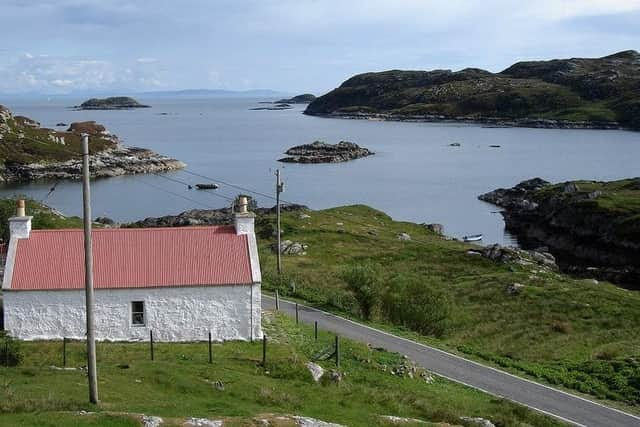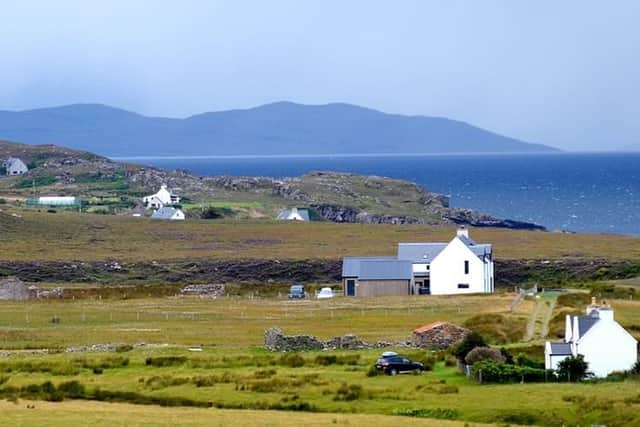Crofting’s new chief sets his stall out with a positive message


From assignations to common grazing entitlements, to maps and boundaries, to numerous subsidy layers, the land register and various government decrees and acts dating back to 1888. It can befuddle the best, before you even put a spade in the ground. There’s a very good reason why you have specialist crofting lawyers.
And at the centre of it all, for good or evil depending on your personal experience, is the Crofting Commission, the regulatory body set up to ensure that crofting legislation is followed and enacted.
Advertisement
Hide AdAdvertisement
Hide AdRecent history has not been kind. In 2021, Audit Scotland produced a highly critical report which in essence said the commission was not properly fulfilling its objectives as the lines of responsibility between its board and the Scottish Government, who employ its officers, were too blurred. It should be noted that a follow-up report recorded marked improvements.


Meanwhile, in the crofting counties, the collective sound of wailing can be heard at the mere mention of the word “commission”, with deep-seated anger at the length of time even straight-forward regulatory matters are processed and handled.
There is also concern over the exorbitant price for crofts, sold on the open market for housing as opposed to any agricultural potential, which is preventing some young families from staying in their home communities, although in that respect at least the commission insists their powers are fairly limited.
Regardless, it’s quite a formidable quagmire for a new chief executive to be stepping into, but Gary Campbell, an Inverness based accountant, seems undaunted.
Advertisement
Hide AdAdvertisement
Hide AdHis appointment was announced back in October and last week he was in Stornoway to meet with the commission’s area representatives (formerly the local assessors) and other stakeholders with a key message: “We want to work in partnership.”


He has one thing immediately in his favour anyway which will be a welcome departure: he is no staid government civil servant, as even a short time in his company will testify. He is at least relatable on a human level.
“I grew up in Argyll, in Taynuilt, in a crofting village,” he said, during an interview in the Woodlands Cafe in the Castle Grounds in Stornoway. “My family have had a croft there, oh, since further back than official records even began. My mother is still there as the crofter.
“I’m not an active crofter myself. As a child I got nagged into doing the hay and whatever needed to be done, but I was more interested in getting away to Glasgow. So off I went to university to do accountancy; I’m a chartered accountant. But I quickly moved back to the Highlands for work and have lived in Inverness for the last 30 years. My wife’s from Alness and the family’s grown up in Inverness.”
Advertisement
Hide AdAdvertisement
Hide AdAfter working for Ernst and Young and a stint self-employed, he ran a manufacturing business in Tain which made metal bins for hospitals. They had clients right throughout the UK and even internationally, “including the Western Isles Health Board – I’ve been at the hospital here inspecting their bins”.
From there he joined the rapidly expanding UHI, where he has worked for the last 12 years, as a “key accountant director”, essentially liaising with external organisations and businesses as to how UHI can meet the employment and economic needs of the region. “I have travelled extensively throughout the Highlands and know the issues,” he says.
So definitely not a government insider, but not exactly a welly-wearing man of the soil either. Which begs the rather obvious question: where does the inspiration to lead crofting’s main public body come from?
“My father died ten years ago. My mother is in her eighties. Although she’s still organising stuff on the croft, even to this day, I was left with the admin, putting it on the land register and sorting out the fact my father had died.
Advertisement
Hide AdAdvertisement
Hide Ad“It was an eye opener in terms of all the processes and where the pitfalls were, I have to say. If you step back it should be straightforward but there’s a whole lot of things that can stop and block the process.
“We had boundary issues with the croft. There was no dispute at all, just that it hadn’t been sorted with the neighbouring croft and it took forever to sort. And then you had the common grazing and maintenance of ditches. So I’ve had quite a lot of experience of all that in the last 10 years.
“So when I saw the job, after someone shared it on Linkedin, I thought: Do you know what? I'd like to do that. It’s a very different job, being in charge of a regulatory body, but the thing that really appealed to me was the line in the legislation that requires the commission to ‘promote the interests of crofting’.
“And the more I looked into it, the more interesting it became. You have the Crofters Holding Act of 1888 and I couldn’t find any other system of regulatory land tenure anywhere in the world that has lasted so long: not the state farms in Russia; not Chairman Mao’s great experiment in China. Crofting has out-lasted them all.
Advertisement
Hide AdAdvertisement
Hide Ad“That means, and I explained this when I applied for the job, that it’s been a massive success and the reason why it hasn’t really changed. It is substantially the same as it was in 1888 and I think that's a huge plus for the Highlands and Islands. You have different and modern forms of crofting, for sure, but they’re there to develop and enhance communities and that’s what it was designed for – to stop people being pushed into the sea – and the commission exists to ensure that’s done fairly and correctly within the framework of the law.”
That’s the broad principles and philosophy dealt with then. But the key issue is not why the commission actually exists, or even the indisputable benefits that crofting brings. It is how the commission executes its functions as a regulator and how an over-bearing bureaucratic monster can be tamed so that it can assist rather than hinder.
Maintaining his optimistic and upbeat manner, the new chief executive believes there is real improvement in the offing, and just around the corner, with more staff recently added to deal with a significant backlog of applications. And that should yield results soon, he says.
“The commission went from being a totally office based organisation before Covid to overnight being a remote business. Other places like UHI had remote working, but the commission wasn’t like that at all. So there’s a hiatus in terms of how an organisation of 70 odd folk change their practices. There was a backlog and we’re still working through it. But we’re getting there.”
Advertisement
Hide AdAdvertisement
Hide AdSo, when will this improvement be seen? “I would think, within the next year.”
He further explains that as well as additional staff “getting up to speed”, there’s a new determination from board members to be “more bullish in our decision-making; to make decisions more quickly and more straightforwardly - that’s something that’s new as well, so there’s a change”.
But, as well as an internal shake-up, there is the external. He believes that there needs to be a wider understanding of where the commission’s responsibilities extend to and, even more crucially perhaps, where they don’t. In essence, what’s possible within their remit.
He recognises the real frustration of crofts being sold on the open market for sums way beyond what any young family can afford, with new owners/tenants having dubious – at best – crofting credentials. But their hands are tied, he insists.
Advertisement
Hide AdAdvertisement
Hide Ad“Most of these issues are actually nothing to do with the commission, because we can only regulate once people are on the croft. The productive use of a croft is quite wide in scope. We have to take people at face value that they are going to do the right thing. The open market is not something we can interfere with. And in terms of multiple housing, that's a planning issue.”
However, he was keen to stress that it was not a case of standing by and allowing the situation to continue.
“But we need the help of the crofting communities. We’re hearing about all these neglected crofts when we’ve got young people wanting crofts. So how many young people? Well through the official Scottish Land Matching service (a government run scheme) it’s 192. Now people have said it’s much more than that. Well, we don’t know; we can only go on the official figure.
“The reality is the commission can’t do anything until someone tells us. So we need someone in the community to say there is an issue. I’ve heard on a number of occasions someone saying that such and such a croft is not being used properly. And I said well you have to tell us and the response is: ‘Oh, I can't’. Well, there’s not much we can do.
Advertisement
Hide AdAdvertisement
Hide Ad“However, there is an annual census that a number of people ignore. From this year onwards we’re going to pick a sample from ‘serial non returners’ and we’re going to see what’s being done. So we will be out and about in the community. We will be checking up.
“But it won't be like the crofting police. We’ll contact the crofters and the landowner and ask what we can do? We will approach it from a land use point of view and work with the crofter to see how we can make it work for them.”
As someone coming to crofting fairly new – or at least rekindling an old family link – he says he noticed one glaring omission which when resolved should really help, at least in terms of that key responsibility ‘to promote the interest of crofting’.
“One piece of work we’re looking at is a proper evaluation of what crofting brings to Scotland. It’s never been done. I know because I went looking for it when I applied for the job and it wasn’t there.
Advertisement
Hide AdAdvertisement
Hide Ad“Hopefully by the end of the summer we’ll have that piece of work completed. As I said, crofting must be working. It’s 138 years old. If it wasn’t working, it’d be gone.
“But just how much does it contribute? We know from studies undertaken by the commission about 30 years ago that it has absolutely helped with population decline. But what else? We’re going to look at all the things that crofting has done in its widest sense and in the context of what the 1888 act was set up to do.”
There will certainly be plenty keeping a watching brief on the outcome at that. But equally, too, so will the performance of the commission itself continue to be scrutinised, and in particular that promised improvement that’s supposed to be coming.